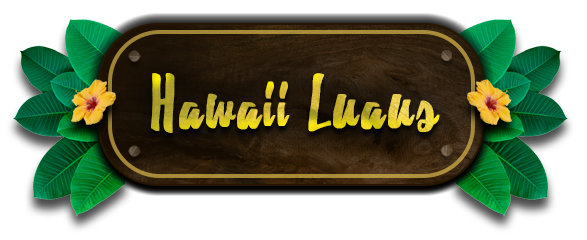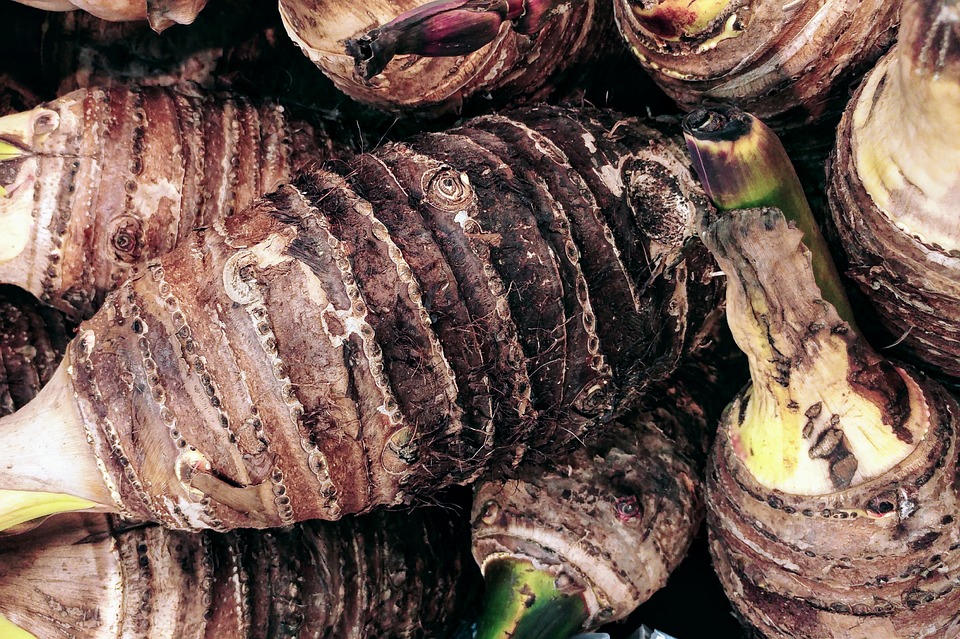Taro in Hawaiian Culture
by Hayley L., February 20, 2020
The Hawaiian word for taro is kalo. Taro is a beautiful, sturdy, and useful plant. Grown in ponds or paddies, taro’s thick stems and large heart-shaped green leaves are easily identifiable.
As is the case with most things Hawaiian, taro’s origin story starts as a myth.

The Legend of Haloanaka and Ohana
The Hawaiian word for family is ohana, which comes from the name of the young shoots on a taro plant, oha. Hawaiian legends say taro was the stillborn child of the sky god, Wakea, and the keeper of the stars, Ho’ohokukukalani. When these gods of the heavens saw that their child didn’t survive birth they were heartbroken, and lovingly buried the child in the earth. Eventually, a taro plant grew from the child’s body, named Haloanaka (long, trembling stalk).
Later, Wakea and Ho’ohokukukalani’s second try at producing offspring resulted in the birth of a mortal human child named Haloa. Haloanaka, Haloa’s sibling in plant form, helped Haloa survive by providing him with nourishment. Haloa grew up to become the first ancestor of the Hawaiian people, and Haloanaka became the Hawaiian people’s sustenance.
As the story goes, all Hawaiians are descended from Haloa and they are all children of the skies. Likewise, they are siblings of Haloanaka, the taro plant. Whew. That’s a lot of history (and Hawaiian names), but knowing the legend provides a deeper understanding of why taro is such an important part of Hawaiian culture.
The Role of Taro in Early Hawaiian Culture

Taro is one of the oldest cultivated crops in the world. It originated in Asia but was eventually brought to New Zealand, (Aotearoa in the Polynesian Maori language). The early Polynesians adopted it and brought it along on their ocean voyages. The plant was well suited for the tropical Polynesian islands, thriving near rivers and streams.
Taro became an important and sacred part of Hawaiian tradition. It was used as medicine and as a vital food source. How taro was farmed and where it grew dictated how and where the Hawaiian people lived. Because taro requires a large amount of water to grow, Hawaiians established their living areas near the lo’i, pond fields where taro could be grown easily. At one point in time, much of the land in Waikiki was used to grow taro.
Taro was the staple food for the ancient Hawaiians. Taro is nutrient–rich and dense in calories. The ancient Hawaiians used or ate every part of the taro plant. The root (technically, it’s called the corm) was mashed into poi. A starchy fermented paste that became a staple in the Hawaiian diet. Meanwhile, the taro leaves, known as luau, were steamed and consumed. The taste of taro leaves is similar to other leafy greens like spinach or chard. The leaves were also sometimes used to hold water and food.
Cooking with Taro
Taro isn’t safe to consume in raw form. It contains tiny crystals called calcium oxalate. These crystals can cause the skin to itch and, if eaten raw, can make the mouth and throat feel dry and scratchy. It’s essential to cook taro thoroughly to get rid of the calcium oxalate
Some cooks wear gloves to protect their skin when cutting or grating raw taro. Some recommend boiling the taro root before even starting to work with it, enabling them to chop and grate without irritating their skin.
Taro at a Luau

As taro was essential for their survival and also considered an ancestor, Hawaiians also incorporated taro into their celebrations and art. Taro is revered in chants and dances to this day and is included on the table at every luau.
The luau gets its very name from the taro leaf (luau), after a common luau dish, squid luau.
If you attend a Hawaiian luau, you’ll find taro in a few different recipes, including taro rolls and possibly even lau lau (meats wrapped and steamed in the taro leaves) if you attend the Nutridge Luau. Commercial luaus usually don’t serve squid luau, but most do serve the best-known food made from taro, poi.
Although many visitors don’t appreciate the flavor, having poi at a luau is a cultural nod to taro’s position as part of the ohana and as sustenance for the Hawaiian people. Most luaus serve poi in tiny cups, so guests can at least try it.
Poi, Hawaii’s Staple Starch
Poi was the primary way in which ancient Hawaiians consumed taro. The cooked, mashed, and fermented root of taro, poi looks like a light purple pudding or paste. At first glance, it may not be the most beautiful dish on the buffet table.
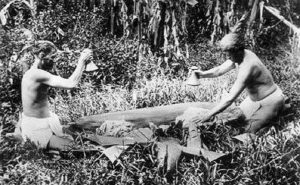
The traditional process of making poi was a time-consuming labor of love. After cooking for several hours in an underground oven called an imu, taro was then pounded on large boards or humongous bowls using a heavy stone. The cooked taro was pounded over and over until a silky smooth paste formed. Water was added, little by little, until the desired consistency was reached.
Poi is an acquired taste. When consumed fresh, poi tastes fairly bland. When fermented, it can taste sour. Some people like to mix sugar or honey into their poi to add a bit of sweetness.
The poi served at a luau is typically more on the bland side. Many visitors try it by itself, but it is served to cut the salty and rich flavors of the other luau delicacies. Poi by itself is nothing special, but a nice juicy bite of kalua pork dipped in poi is fantastic.
How to Eat Poi
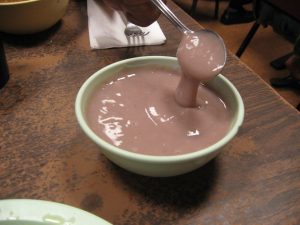
Ancient Hawaiians had no eating utensils, and they scooped poi with two or three fingers and popped it into their mouths. Some locals still eat poi this way. You don’t have to do the same. It’s perfectly polite to consume poi with a spoon!
Poi can be eaten on its own or used as a dip or side dish. At a luau, poi can be mixed with other food items on the plate and eaten with a fork or spoon. Pieces of fish or other food can be dipped into the poi.
Due to its paste-like texture and bland flavor, poi can be eaten with almost anything. Poi is still served in local homes in Hawaii. It’s not hard to find someone who dips their French Fries or potato chips in the stuff!
Where Can You Find Poi?
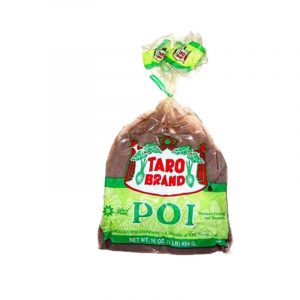
Besides a luau, poi can be found in most grocery stores in Hawaii. Poi usually comes in either a plastic bag or a small plastic container. Popular brands include Taro Brand and Aloha Aina.
If you’re interested in touring a lo’i or seeing the process of poi pounding, there are locations where you can not only visit but participate and learn. Ka’ala Farm in Waianae offers scheduled tours. Ka’ala Farm is part of a community program that works to educate visitors about Hawaiian traditions.
If you’d like to learn about poi-making and do a good deed at the same time, schedule a volunteer day at Papahana Kuaola.They welcome volunteers to come and work in their lo’i by planting, maintaining, harvesting, and pounding taro. It’s a fun, educational day out.
Do You Know that Taro is a Superfood?
The ancient Hawaiians understood how valuable taro was to the human body. Research has since shown taro to be a superfood. It provides the body with an immune boost and serves as a potent antioxidant. Rich in potassium, Vitamin C, copper, and magnesium, it can help prevent anemia and aid the cardiovascular system.
Taro is made up of starchy carbohydrates and is high in calories. However, the carbohydrates in taro are the kind that are good for you. Taro also offers cholesterol-lowering benefits owing to the type of fiber it contains.
Poi has been used by ancient and modern Hawaiian mothers alike as baby food. Often, local mothers use poi as one of the first foods introduced to their babies. Its bland taste, smooth consistency, and numerous health benefits make poi the perfect food for a baby’s taste buds.
Modern Taro Dishes
Due to its new status as a superfood, taro is no longer just an exotic Polynesian delicacy. Taro has made its way into recipes all over the world.
Taro chips are a crunchy treat. A little thicker and sturdier than a typical potato chip, a taro chip holds its shape better than a potato chip and has a satisfying crunch. Taro chips are also healthier than potato chips because they have more fiber and beneficial starches. Outside Hawaii, they can often be found at Asian markets.
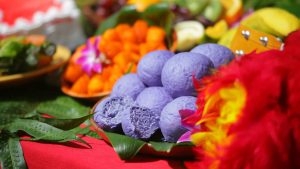
Taro malasadas—a kind of doughnut—and poi mochi balls are common snack staples in the islands. Poi adds a beautiful, vibrant purple color to pastries and breads. These poi desserts have also become part of many luau menus.
Instead of regular white dinner rolls, you may see taro rolls at your luau, as well as on local restaurant tables and in the markets. Pretty as well as delicious, taro dinner rolls are a welcome addition to Hawaiian meals.
Ask anyone who grew up here and they’ll have an opinion or a story about poi. Some will recall being taught how to cook and pound poi by their grandparents. Others will talk about debating with their friends about whether two-finger or three-finger poi is better. Locals describe the constancy of their poi by how many fingers it takes to scoop it up. Others will tell you how the appearance of poi at the table meant that the gathering was a special event.
What it all boils down to is this: for Hawaiians, taro will always be about ohana. It’s just not a proper luau party without the poi!

